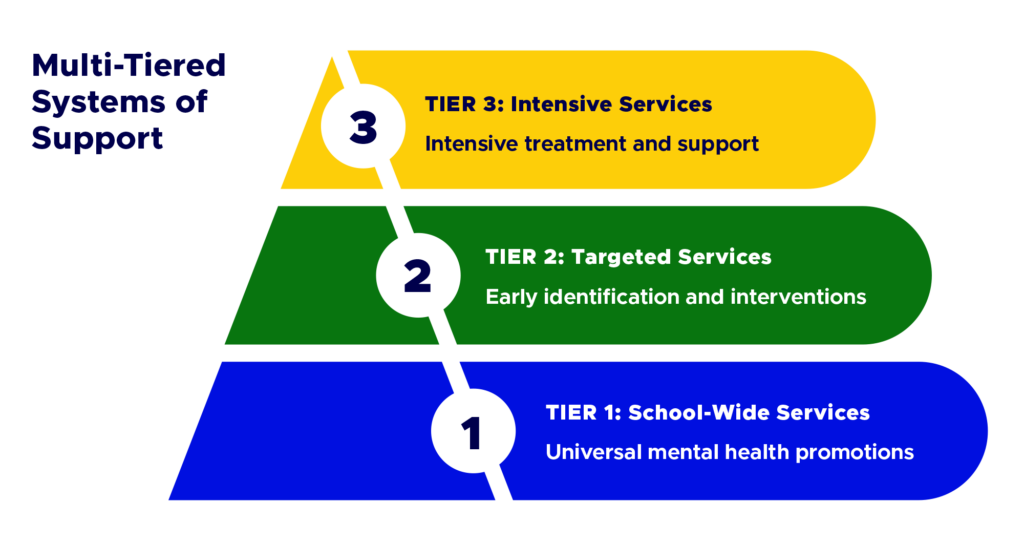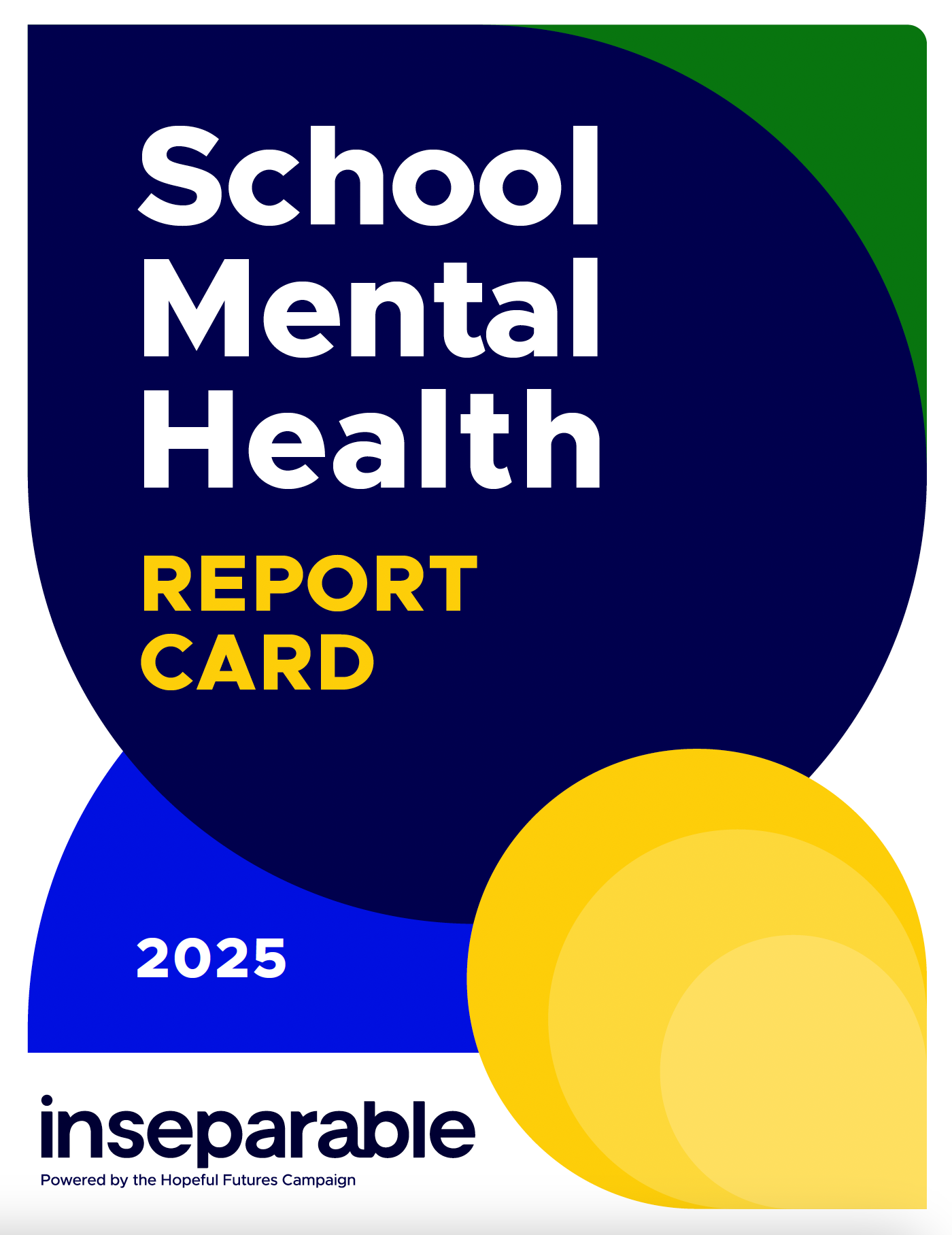experienced at least 1 major depressive episode in the past year
No one's worst day should keep them from living their best life.
School Mental Health:
Policies to Improve Student Wellbeing
Recent data show investments in school-based mental health supports are having a positive impact on our youth. There is still more to be done to ensure every child’s school has effective programs in place that promote mental wellbeing for all students and offer mental health services and support to those who need it.
More than 20% of youth
More than HALF of youth
with major depression did not receive mental health treatment
Lorem Ipsum
dolor sit amet, consectetur adipiscing elit, sed do eiusmod tempor
More than 20% of youth
experienced at least 1 major depressive episode in the past year
More than HALF of youth
with major depression did not receive mental health treatment
Lorem Ipsum
dolor sit amet, consectetur adipiscing elit, sed do eiusmod tempor
More than 20% of youth
experienced at least 1 major depressive episode in the past year
More than HALF of youth
with major depression did not receive mental health treatment
Lorem Ipsum
dolor sit amet, consectetur adipiscing elit, sed do eiusmod tempor
There is a Solution
Centered on prevention, Multi-Tiered Systems of Support (MTSS) is a simple, proven framework to help schools partner with students, families, and communities in providing an array of mental health instruction and supports that meet the varying needs of each student. View state policies that support schools in adopting this model.

State Snapshots
Understand your state’s progress in adopting policies that strengthen and improve school-based mental health services for our youth. For insights on these policy benchmarks, read this overview.
[{"state":"Alabama","link":"https:\/\/www.inseparable.us\/download\/Alabama-school-mental-health","label":"See Snapshot"},{"state":"Alaska","link":"https:\/\/www.inseparable.us\/download\/Alaska-school-mental-health","label":"See Snapshot"},{"state":"Arizona","link":"https:\/\/www.inseparable.us\/download\/Arizona-school-mental-health","label":"See Snapshot"},{"state":"Arkansas","link":"https:\/\/www.inseparable.us\/download\/Arkansas-school-mental-health","label":"See Snapshot"},{"state":"California","link":"https:\/\/www.inseparable.us\/download\/California-school-mental-health","label":"See Snapshot"},{"state":"Colorado","link":"https:\/\/www.inseparable.us\/download\/Colorado-school-mental-health","label":"See Snapshot"},{"state":"Connecticut","link":"https:\/\/www.inseparable.us\/download\/Connecticut-school-mental-health","label":"See Snapshot"},{"state":"Delaware","link":"https:\/\/www.inseparable.us\/download\/Delaware-school-mental-health","label":"See Snapshot"},{"state":"District of Columbia","link":"https:\/\/www.inseparable.us\/download\/District-of-Columbia-school-mental-health","label":"See Snapshot"},{"state":"Florida","link":"https:\/\/www.inseparable.us\/download\/Florida-school-mental-health","label":"See Snapshot"},{"state":"Georgia","link":"https:\/\/www.inseparable.us\/download\/Georgia-school-mental-health","label":"See Snapshot"},{"state":"Hawaii","link":"https:\/\/www.inseparable.us\/download\/Hawaii-school-mental-health","label":"See Snapshot"},{"state":"Idaho","link":"https:\/\/www.inseparable.us\/download\/Idaho-school-mental-health","label":"See Snapshot"},{"state":"Illinois","link":"https:\/\/www.inseparable.us\/download\/Illinois-school-mental-health","label":"See Snapshot"},{"state":"Indiana","link":"https:\/\/www.inseparable.us\/download\/Indiana-school-mental-health","label":"See Snapshot"},{"state":"Iowa","link":"https:\/\/www.inseparable.us\/download\/Iowa-school-mental-health","label":"See Snapshot"},{"state":"Kansas","link":"https:\/\/www.inseparable.us\/download\/Kansas-school-mental-health","label":"See Snapshot"},{"state":"Kentucky","link":"https:\/\/www.inseparable.us\/download\/Kentucky-school-mental-health","label":"See Snapshot"},{"state":"Louisiana","link":"https:\/\/www.inseparable.us\/download\/Louisiana-school-mental-health","label":"See Snapshot"},{"state":"Maine","link":"https:\/\/www.inseparable.us\/download\/Maine-school-mental-health","label":"See Snapshot"},{"state":"Maryland","link":"https:\/\/www.inseparable.us\/download\/Maryland-school-mental-health","label":"See Snapshot"},{"state":"Massachusetts","link":"https:\/\/www.inseparable.us\/download\/Massachusetts-school-mental-health","label":"See Snapshot"},{"state":"Michigan","link":"https:\/\/www.inseparable.us\/download\/Michigan-school-mental-health","label":"See Snapshot"},{"state":"Minnesota","link":"https:\/\/www.inseparable.us\/download\/Minnesota-school-mental-health","label":"See Snapshot"},{"state":"Mississippi","link":"https:\/\/www.inseparable.us\/download\/Mississippi-school-mental-health","label":"See Snapshot"},{"state":"Missouri","link":"https:\/\/www.inseparable.us\/download\/Missouri-school-mental-health","label":"See Snapshot"},{"state":"Montana","link":"https:\/\/www.inseparable.us\/download\/Montana-school-mental-health","label":"See Snapshot"},{"state":"Nebraska","link":"https:\/\/www.inseparable.us\/download\/Nebraska-school-mental-health","label":"See Snapshot"},{"state":"Nevada","link":"https:\/\/www.inseparable.us\/download\/Nevada-school-mental-health","label":"See Snapshot"},{"state":"New Hampshire","link":"https:\/\/www.inseparable.us\/download\/New-Hampshire-school-mental-health","label":"See Snapshot"},{"state":"New Jersey","link":"https:\/\/www.inseparable.us\/download\/New-Jersey-school-mental-health","label":"See Snapshot"},{"state":"New Mexico","link":"https:\/\/www.inseparable.us\/download\/New-Mexico-school-mental-health","label":"See Snapshot"},{"state":"New York","link":"https:\/\/www.inseparable.us\/download\/New-York-school-mental-health","label":"See Snapshot"},{"state":"North Carolina","link":"https:\/\/www.inseparable.us\/download\/North-Carolina-school-mental-health","label":"See Snapshot"},{"state":"North Dakota","link":"https:\/\/www.inseparable.us\/download\/North-Dakota-school-mental-health","label":"See Snapshot"},{"state":"Ohio","link":"https:\/\/www.inseparable.us\/download\/Ohio-school-mental-health","label":"See Snapshot"},{"state":"Oklahoma","link":"https:\/\/www.inseparable.us\/download\/Oklahoma-school-mental-health","label":"See Snapshot"},{"state":"Oregon","link":"https:\/\/www.inseparable.us\/download\/Oregon-school-mental-health","label":"See Snapshot"},{"state":"Pennsylvania","link":"https:\/\/www.inseparable.us\/download\/Pennsylvania-school-mental-health","label":"See Snapshot"},{"state":"Rhode Island","link":"https:\/\/www.inseparable.us\/download\/Rhode-Island-school-mental-health","label":"See Snapshot"},{"state":"South Carolina","link":"https:\/\/www.inseparable.us\/download\/South-Carolina-school-mental-health","label":"See Snapshot"},{"state":"South Dakota","link":"https:\/\/www.inseparable.us\/download\/South-Dakota-school-mental-health","label":"See Snapshot"},{"state":"Tennessee","link":"https:\/\/www.inseparable.us\/download\/Tennessee-school-mental-health","label":"See Snapshot"},{"state":"Texas","link":"https:\/\/www.inseparable.us\/download\/Texas-school-mental-health","label":"See Snapshot"},{"state":"Utah","link":"https:\/\/www.inseparable.us\/download\/Utah-school-mental-health","label":"See Snapshot"},{"state":"Vermont","link":"https:\/\/www.inseparable.us\/download\/Vermont-school-mental-health","label":"See Snapshot"},{"state":"Virginia","link":"https:\/\/www.inseparable.us\/download\/Virginia-school-mental-health","label":"See Snapshot"},{"state":"Washington","link":"https:\/\/www.inseparable.us\/download\/Washington-school-mental-health","label":"See Snapshot"},{"state":"West Virginia","link":"https:\/\/www.inseparable.us\/download\/West-Virginia-school-mental-health","label":"See Snapshot"},{"state":"Wisconsin","link":"https:\/\/www.inseparable.us\/download\/Wisconsin-school-mental-health","label":"See Snapshot"},{"state":"Wyoming","link":"https:\/\/www.inseparable.us\/download\/Wyoming-school-mental-health","label":"See Snapshot"}]
Policy Recommendations
States are uniquely positioned to ensure students have access to the appropriate resources and supports they need by adopting policies and leveraging sustainable funding models that allow for continuity and quality. This report is designed to support state policymakers in adopting effective policies in six areas:
- Permit excused absences for mental health and offer the student and their parent or caregiver information on mental health support following two or more absences
- Adopt regular training and coaching of teachers and school staff on mental health, suicide prevention, and substance use disorders
- Expand mental health supports for teachers and school staff
- Implement alternatives to exclusionary discipline (e.g. suspension and expulsion), such as referrals to counseling or behavioral supports
- Update anti-bullying and harassment policies to ensure they effectively address emerging trends in harmful behaviors
- Promote skills for life success
- Require age-appropriate mental health education in grades K–12
- Increase suicide prevention awareness and training for students
- Direct schools that issue student ID cards to include the 988 Suicide and Crisis Lifeline or other crisis help lines
- Require every school district to adopt an MTSS or Positive Behavioral Interventions & Supports framework for delivering school mental health services to students
- Facilitate safe means for reporting mental health concerns, such as through a digital platform
- Provide annual mental health screenings
- Engage families and caregivers in supporting youth mental health
- Implement school-linked telemental health programs to supplement school-based services or provide access in under-staffed schools
- Facilitate school-linked mental health programs that provide access to community mental health professionals on school grounds
- Require school-based health centers to provide onsite mental health expertise or access to mental health services via telemental health
- Fund school or school district coordinators to facilitate school, community, and family connections
- Fund state-level positions to coordinate across agencies and support local education agencies in implementing school mental health programs
- Improve the ratios of school psychologists, school social workers, and school counselors
- Establish and fund a school mental health workforce development program, including through training and education programs for school-based mental health professionals and by creating pathways for youth
- Establish and fund loan repayment and other financial incentive programs to help recruit and retain school-based mental health professionals
- Ease administrative barriers to entering the field, including by improving and streamlining licensure and credentialing requirements
- Provide technical assistance to school staff around youth mental health best practices
- Ensure the state Medicaid plan covers school-based mental health services, including preventative and telehealth services, for all Medicaid-enrolled students
- Update the state Medicaid plan, as needed, to allow all school mental health providers to bill Medicaid, including youth peer supports
- Allow youth to receive needed mental health services without a formal diagnosis under the state Medicaid plan
- Ensure commercial health insurance supports school-based mental services
Resources
The State of Mental Health in America
State-by-state insights into the accessibility of care for mental health and substance use disorders
Mental Health First Aid for Youth
NAMI Basics OnDemand
2023 Legislative Guide
The State of Mental Health in America
State-by-state insights into the accessibility of care for mental health and substance use disorders
